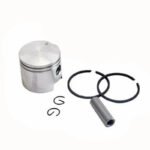Essential Maintenance Tips for Your Brush Cutter
Introduction Maintaining your brush cutter is vital to ensure its longevity and optimal performance. For farmers, landscapers, and DIY enthusiasts, regular maintenance can significantly reduce downtime and costly repairs. In this article, we will cover the essential maintenance tips, focusing on regular cleaning, lubrication, and inspection, to help you keep your brush cutter in top shape.
Importance of Regular Maintenance Regular maintenance is crucial for several reasons:
- Prolongs Equipment Life: Regular upkeep helps prevent wear and tear, extending the life of your brush cutter.
- Enhances Performance: Well-maintained equipment operates more efficiently, saving time and effort.
- Prevents Costly Repairs: Early detection of issues can prevent minor problems from escalating into major, expensive repairs.
- Ensures Safety: Proper maintenance reduces the risk of accidents caused by malfunctioning equipment.
Cleaning Your Brush Cutter Keeping your brush cutter clean is one of the simplest yet most effective maintenance tasks. Here’s how to do it:
Step-by-Step Cleaning Guide:
- Remove Debris and Dirt: After each use, remove any debris, dirt, or grass clippings from the cutting head and guard.
- Clean the Air Filter: Check the air filter regularly. If it’s dirty, clean it according to the manufacturer’s instructions or replace it if necessary.
- Clean the Cooling Fins: Dust and debris can accumulate on the cooling fins, affecting the engine’s performance. Use a soft brush to clean them.
- Wipe Down the Engine and Handle: Use a damp cloth to wipe down the engine and handle, removing any dirt or grime.
Tools and Materials Needed:
- Brush or scraper
- Soft cloth
- Mild detergent
- Water
Frequency:
- Clean your brush cutter after each use to prevent buildup.
- Perform a thorough cleaning at the end of the season before storing the equipment.
Lubrication Lubricating the moving parts of your brush cutter is essential to reduce friction and prevent wear. Here’s what you need to know:
Types of Lubricants:
- Engine Oil: Use the type recommended by the manufacturer for the engine.
- Grease: Apply grease to the gearbox and other moving parts as specified in the manual.
Lubrication Points:
- Gearbox: Lubricate the gearbox to ensure smooth operation.
- Moving Parts: Apply lubricant to all moving parts, including the cutting blades and any hinges or joints.
Application Methods:
- Follow Manufacturer’s Instructions: Always use the type and amount of lubricant specified in the manual.
- Regular Application: Lubricate your brush cutter regularly, especially after heavy use or exposure to harsh conditions.
Inspection and Maintenance Regular inspection helps identify potential issues before they become major problems. Here’s a checklist to guide you:
Regular Inspection Checklist:
- Cutting Tools: Check the blades for sharpness and damage. Replace or sharpen as needed.
- Air Filter: Inspect the air filter and clean or replace it if it’s dirty.
- Spark Plug: Check the spark plug for wear and replace it if necessary.
- Fuel System: Inspect the fuel lines and tank for leaks or damage.
- Bolts and Nuts: Ensure all bolts and nuts are tight and secure.
Common Issues to Look For:
- Worn or Damaged Blades: Sharp blades are crucial for efficient cutting. Replace damaged or dull blades.
- Loose Parts: Tighten any loose bolts or nuts to prevent parts from falling off during operation.
- Oil Leaks: Check for oil leaks, which can indicate a need for gasket or seal replacement.
Troubleshooting Tips:
- Engine Won’t Start: Check the fuel level, spark plug, and air filter. Ensure the choke is set correctly.
- Poor Cutting Performance: Inspect the blades and ensure they are sharp and properly installed.
- Excessive Vibration: Tighten any loose parts and check for bent or damaged components.
Seasonal Maintenance Different seasons require different maintenance tasks to keep your brush cutter in top condition.
Early Season Maintenance:
- Oil Change: Change the oil before the start of the season to ensure the engine runs smoothly.
- Spark Plug Check: Inspect the spark plug and replace it if it shows signs of wear.
- General Inspection: Perform a thorough inspection and address any issues found.
End-of-Season Maintenance:
- Thorough Cleaning: Clean the entire brush cutter, removing all debris and dirt.
- Fuel System Maintenance: Drain the fuel tank and carburetor to prevent gum deposits from forming during storage.
- Store Properly: Store the brush cutter in a dry, sheltered location to protect it from the elements.
Professional Servicing While regular DIY maintenance is essential, professional servicing can address more complex issues.
When to Seek Professional Help:
- Persistent Problems: If you notice recurring issues that you can’t resolve, it’s time to consult a professional.
- Major Repairs: Significant repairs, such as engine overhauls, should be handled by experienced technicians.
Finding a Reliable Service Provider:
- Reputation: Look for service providers with good reviews and a solid reputation.
- Certification: Ensure the technicians are certified and experienced in handling brush cutters.
- Warranty: Choose service providers that offer a warranty on their work.
Conclusion Maintaining your brush cutter through regular cleaning, lubrication, and inspection is crucial for its longevity and performance. By following these essential maintenance tips, you can ensure your equipment operates efficiently, reducing downtime and costly repairs. Remember, proper maintenance is an investment in the lifespan of your machinery.
Visit lakparts.com for more information and to explore our products! Whether you need high-quality replacement parts or expert advice, LakParts.com has everything you need to keep your machinery running smoothly.




